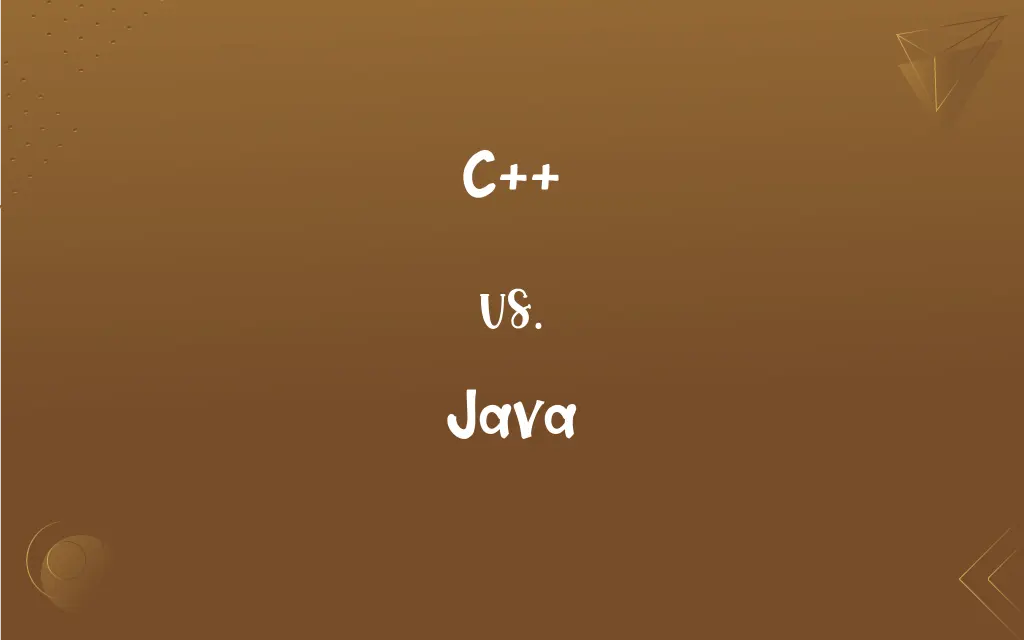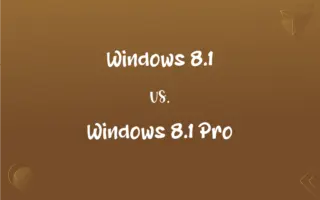C++ vs. Java: What's the Difference?
Edited by Janet White || By Harlon Moss || Updated on October 26, 2023
C++ is an object-oriented programming language with low-level capabilities; Java is an object-oriented language that runs on a virtual machine.

Key Differences
C++ is a direct successor of the C language, introducing object-oriented features to its procedural predecessor. Java, on the other hand, was designed to be simpler than C++ and to support network computing, which was becoming increasingly important at its time of introduction.
C++ code is typically compiled to machine code for a specific platform. This means software written in C++ needs to be compiled separately for each platform it's meant to run on. Java, conversely, is compiled to bytecode, which runs on the Java Virtual Machine (JVM), making it platform-independent as long as the JVM exists for the platform.
Memory management in C++ is manual, using explicit constructs like "new" and "delete" for dynamic memory allocation and deallocation. In Java, memory management is largely automatic, with the garbage collector reclaiming objects that are no longer in use, eliminating the need for explicit deallocation.
In terms of standard libraries, C++ offers the Standard Template Library (STL) which provides a collection of template classes to help manage data. Java provides a more extensive standard library that covers everything from data structures to networking to graphical user interfaces.
C++ provides more control over system resources and performance due to its proximity to system hardware, making it popular for system/software development and games. Java is generally favored for web applications, mobile apps (Android), and enterprise software due to its platform independence and built-in security features.
ADVERTISEMENT
Comparison Chart
Inheritance
Supports multiple inheritance (using classes)
Supports single inheritance (using classes)
Platform Dependency
Platform-dependent
Platform-independent (runs on JVM)
Memory Management
Manual (using new and delete)
Automatic (garbage collection)
Compilation
Compiles to machine code
Compiles to bytecode for JVM
Standard Libraries
Offers STL
Provides extensive standard libraries
ADVERTISEMENT
C++ and Java Definitions
C++
Offers multiple inheritance through classes.
His C++ project utilized multiple inheritance.
Java
Known for automatic garbage collection.
Java handles memory management automatically.
C++
Commonly used for system software and game development.
The game engine was developed in C++.
Java
Runs on the Java Virtual Machine making it platform-independent.
Java's Write Once, Run Anywhere philosophy appealed to him.
C++
Object-oriented programming language with low-level capabilities.
She designed the software using C++.
Java
Developed by Sun Microsystems, now owned by Oracle.
Oracle continues to release updates for Java.
C++
An extension of the C programming language.
He started programming in C++ at a young age.
Java
A high-level, object-oriented programming language.
She wrote the application in Java.
C++
Allows manual memory management.
Optimizing memory in C++ requires careful management.
Java
Widely used for web and mobile applications.
The Android app was developed in Java.
Java
Brewed coffee.
FAQs
Which came first, C++ or Java?
C++ came before Java.
What makes Java popular for web applications?
Java's platform independence and extensive libraries make it popular for web applications.
Can C++ be used for web applications?
Yes, but it's less common than using languages like Java.
Which language is closer to hardware?
C++ provides more direct control over hardware resources.
What is the JVM?
The JVM, or Java Virtual Machine, is where Java bytecode runs, making the code platform-independent.
Which language requires manual memory management?
C++ requires manual memory management, unlike Java.
Is C++ a superset of C?
Yes, C++ is an extension and superset of the C language.
Which language is commonly used for Android app development?
Java is the primary language for Android app development.
Is Java platform-independent?
Yes, Java runs on the Java Virtual Machine (JVM), making it platform-independent.
Does C++ support object-oriented programming?
Yes, C++ is an object-oriented programming language.
Can Java be used for game development?
Yes, though C++ is often preferred for its performance capabilities.
Which is more performance-oriented, C++ or Java?
C++ is generally considered more performance-oriented due to its direct access to system resources.
How do Java and C++ compare in terms of community support?
Both have extensive communities, though Java's is larger due to its widespread use in web and mobile development.
Which language is known for garbage collection?
Java is known for its automatic garbage collection.
How does C++ handle memory management?
C++ handles memory management manually using constructs like "new" and "delete."
How does C++ handle inheritance?
C++ supports multiple inheritance through classes.
Why is Java popular in enterprise software?
Java's platform independence, scalability, and extensive libraries make it a favorite for enterprise solutions.
Can C++ code be run on the JVM?
No, C++ code doesn't run on the JVM without specific tools or wrappers.
Which offers more extensive standard libraries?
Java offers more extensive standard libraries compared to C++'s STL.
Does Java support multiple inheritance?
Java supports multiple inheritance through interfaces, not classes.
About Author
Written by
Harlon MossHarlon is a seasoned quality moderator and accomplished content writer for Difference Wiki. An alumnus of the prestigious University of California, he earned his degree in Computer Science. Leveraging his academic background, Harlon brings a meticulous and informed perspective to his work, ensuring content accuracy and excellence.
Edited by
Janet WhiteJanet White has been an esteemed writer and blogger for Difference Wiki. Holding a Master's degree in Science and Medical Journalism from the prestigious Boston University, she has consistently demonstrated her expertise and passion for her field. When she's not immersed in her work, Janet relishes her time exercising, delving into a good book, and cherishing moments with friends and family.































































